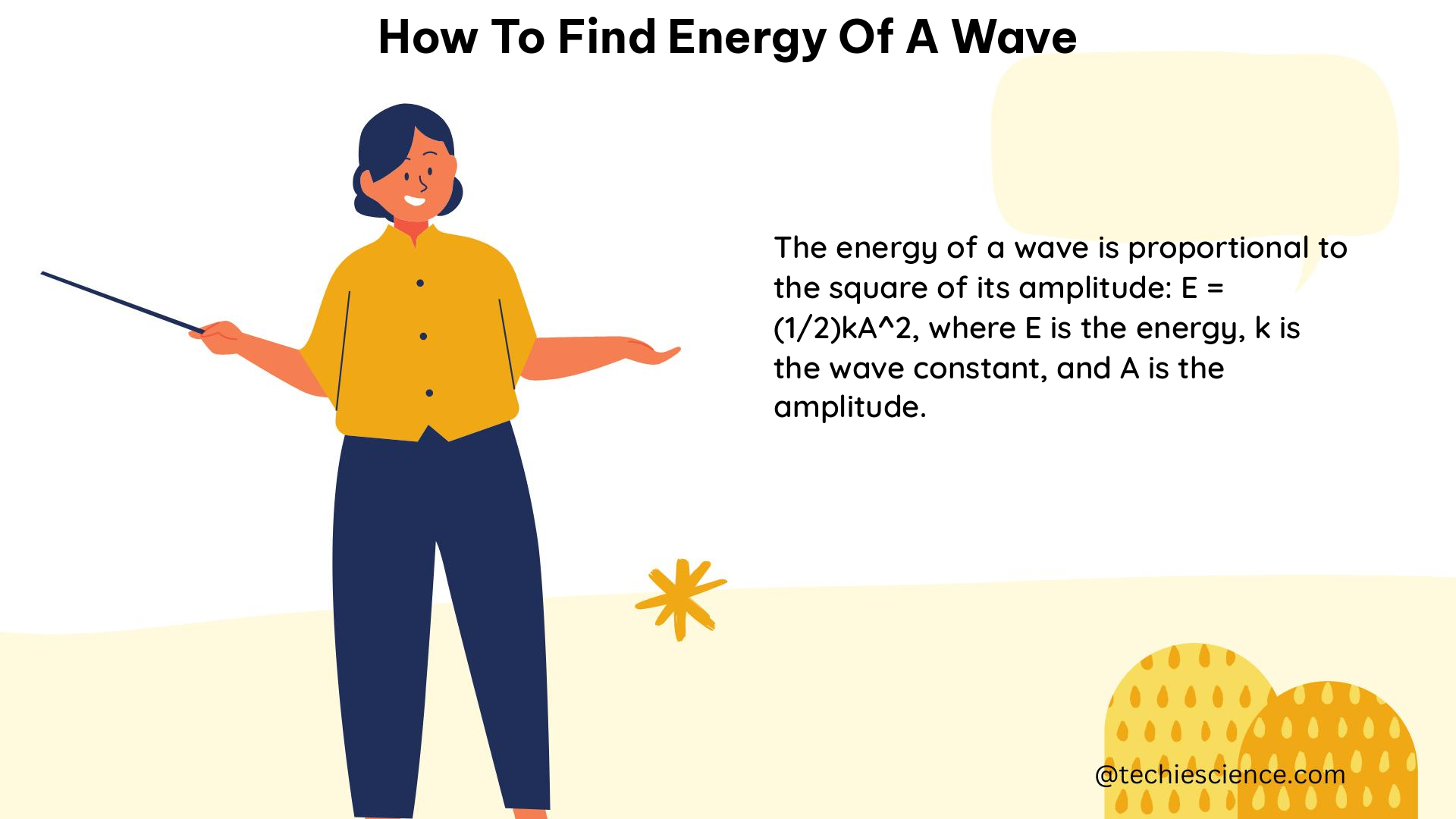The energy of a wave is a fundamental concept in physics, as it represents the amount of energy transported by the wave. To find the energy of a wave, you need to know the amplitude, angular frequency, wavelength, and linear density of the medium. This comprehensive guide will walk you through the step-by-step process of calculating the total wave energy, as well as its kinetic and potential components.
Formula for Total Wave Energy
The total wave energy (U_total) is the sum of the potential energy (U_potential) and kinetic energy (U_kinetic):
$$ U_{total} = U_{potential} + U_{kinetic} = \frac{1}{4}(\mu A^2 \omega^2 \lambda) + \frac{1}{4}(\mu A^2 \omega^2 \lambda) = \frac{1}{2}(\mu A^2 \omega^2 \lambda) $$
Where:
– $\mu$ is the linear density of the medium (kg/m)
– $A$ is the amplitude of the wave (m)
– $\omega$ is the angular frequency of the wave (rad/s)
– $\lambda$ is the wavelength of the wave (m)
Components of Wave Energy

Kinetic Energy (U_kinetic)
The kinetic energy of a wave is the energy associated with the motion of particles in the wave. The formula for kinetic energy is:
$$ U_{kinetic} = \frac{1}{4}(\mu A^2 \omega^2 \lambda) $$
Potential Energy (U_potential)
The potential energy of a wave is the energy associated with the displacement of particles from their equilibrium positions. The formula for potential energy is:
$$ U_{potential} = \frac{1}{4}(\mu A^2 \omega^2 \lambda) $$
Example Problems
Problem 1
Given:
– Amplitude (A) = 10 m
– Angular Frequency (ω) = 50 Hz
– Wavelength (λ) = 10 m
– Linear Density (μ) = 200 kg/m
Calculate the total wave energy.
Solution:
$$ U_{total} = \frac{1}{2}(200 \times 10^2 \times 50^2 \times 10) = 2,500,000 J = 2.5 MJ $$
Problem 2
Given:
– Energy (U) = 0.5 J
– Angular Frequency (ω) = 1 Hz
– Wavelength (λ) = 1 m
– Linear Density (μ) = 1 kg/m
Calculate the amplitude of the wave.
Solution:
$$ U = \frac{1}{2}(\mu A^2 \omega^2 \lambda) $$
$$ 0.5 J = \frac{1}{2}(1 \times A^2 \times 1^2 \times 1) $$
$$ A^2 = 1 m^2 $$
$$ A = 1 m $$
Theoretical Explanation
Wave Energy-Amplitude Relationship
The energy transported by a wave is directly proportional to the square of the amplitude of the wave. This is mathematically expressed as:
$$ E \propto A^2 $$
Wave Energy-Frequency Relationship
The rate of energy transfer in mechanical waves is proportional to both the square of the amplitude and the square of the frequency. If two mechanical waves have equal amplitudes, but one wave has a frequency equal to twice the frequency of the other, the higher-frequency wave will have a rate of energy transfer a factor of four times as great as the rate of energy transfer of the lower-frequency wave.
Additional Data Points and Facts
- The total wave energy is the sum of the kinetic and potential energies, which are equal in magnitude for a traveling wave.
- The energy transported by a wave is directly proportional to the square of the amplitude and the square of the angular frequency.
- The energy transported by a wave is inversely proportional to the wavelength of the wave.
- The power (rate of energy transfer) of a wave is proportional to the square of the amplitude and the square of the angular frequency.
- The energy of a wave can be transported without the transport of matter, as the wave propagates through the medium.
- The energy of a wave can be used to do work, such as in the case of ocean waves being used to generate electricity.
- The energy of a wave can be absorbed or reflected, depending on the properties of the medium and the interface between different media.
References
- GeeksforGeeks. (2024). Energy of a Wave Formula. Retrieved from https://www.geeksforgeeks.org/energy-of-a-wave-formula/
- BYJU’S. (n.d.). Energy of a Wave – Explanation, Formula, Derivation, Video, and FAQs. Retrieved from https://byjus.com/physics/energy-carried-by-a-wave/
- OpenStax. (2016). 16.4 Energy and Power of a Wave. Retrieved from https://openstax.org/books/university-physics-volume-1/pages/16-4-energy-and-power-of-a-wave
- UCF Pressbooks. (n.d.). 16.4 Energy and Power of a Wave. Retrieved from https://pressbooks.online.ucf.edu/osuniversityphysics/chapter/16-4-energy-and-power-of-a-wave/

The lambdageeks.com Core SME Team is a group of experienced subject matter experts from diverse scientific and technical fields including Physics, Chemistry, Technology,Electronics & Electrical Engineering, Automotive, Mechanical Engineering. Our team collaborates to create high-quality, well-researched articles on a wide range of science and technology topics for the lambdageeks.com website.
All Our Senior SME are having more than 7 Years of experience in the respective fields . They are either Working Industry Professionals or assocaited With different Universities. Refer Our Authors Page to get to know About our Core SMEs.